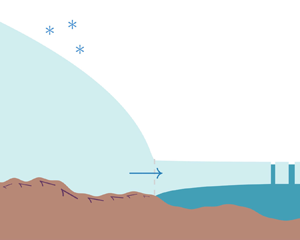Article contents
Grounding-line flux conditions for marine ice-sheet systems under effective-pressure- dependent and hybrid friction laws
Published online by Cambridge University Press: 10 November 2023
Abstract

Flux conditions are semi-analytical expressions that can be used to determine the flux at the grounding line of marine ice sheets. In the glaciology literature, such flux conditions have initially been established for the Weertman and Coulomb friction laws. However, the extension to more general and complex friction laws, such as the Budd friction law, for which basal friction depends on both the basal velocity and the effective pressure, is a topic of recent research. Several studies have also shown that hybrid friction laws, which consider a transition between a power-law friction far from the grounding line and a plastic behaviour close to it, were good candidates for improved modelling of marine ice sheets. In this article, we show that the flux conditions previously derived for the Weertman and Coulomb friction laws can be generalised to flux conditions for the Budd friction law with two different effective-pressure models. In doing so, we build a bridge between the results obtained for these two friction laws. We provide a justification for the existence and uniqueness of a solution to the boundary-layer problem based on asymptotic developments. We also generalise our results to hybrid friction laws, based on a parametrisation of the flux condition. Finally, we discuss the validity of the assumptions made during the derivation, and we provide additional explicit expressions for the flux that stay valid when the bedrock slopes are important or when the friction coefficients are relatively small.
- Type
- JFM Papers
- Information
- Copyright
- © The Author(s), 2023. Published by Cambridge University Press
References
- 1
- Cited by



